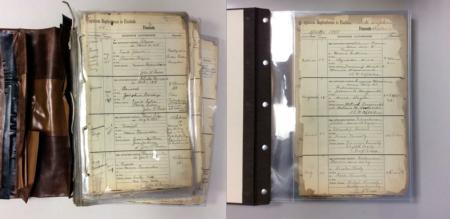Archdiocesan Archive begins to repair sacramental registers
The sacramental record collection is the most frequently used collection in the archive, and, as a result, has prompted the archive staff to take extra steps to preserve its contents.
The collection contains baptism, Eucharist/first Communion, confirmation, marriage, ordination, sick call, and death/burial records. Each instance is entered into a ledger, designated for this particular purpose, and signed by the officiating priest or bishop. These handwritten entries are recognized as the only official copy, so it is vital that we make an effort to preserve them permanently.
The information contained in the ledgers serves a number of official functions, and is a valuable resource to genealogists as well. The most common example of an official use is during marriage preparation. If both the bride and groom are Catholic, and wish to get married in the Catholic Church, these records are used to verify that both have been baptized in the Catholic Church.
As they are so important, the archive is taking steps to ensure their long-term preservation, including an effort to conserve volumes which show signs of significant deterioration and pose the risk of losing the information contained within. Earlier this month marked the completion of the first full conservation treatment, which was completed by the Northeast Document Conservation Center (www.NEDCC.org).
The records in this volume, from St. Stephen Church, Boston, were assembled in a "do-it-yourself" binding which can often be harmful to such fragile records. The pages themselves were brittle, and the edges on four sides were starting to flake away. The pages were housed in non-archival plastic protectors which, not being large enough, were taped together. The plastic protectors were held together by twisted electrical wire, and the cardboard and vinyl cover had a label taped on the front.
The NEDCC took several steps to conserve this volume. First, the pages were removed from the plastic protectors. They were then gently cleaned by hand using a non-abrasive vulcanized rubber sponge, and previous attempts to repair tears with tape were removed and properly treated. Starting from the edges, the pages had taken on a yellowish hue caused by the acid content of the paper. To address this, each page was sprayed with a buffering solution to neutralize the further formation of acid. Finally, each page was encapsulated in an archival quality polyester film, and bound in a new cloth-covered binding. A gold-stamped leather label which includes the parish, record type, and date was added to the spine.
Conservation work is meticulous and exacting, and must be undertaken by professional conservators. As a result, it does come at some cost, but the archive department is hoping to repair one to two volumes each year. If you would like to find out how you can support the conservation work of the Archdiocesan Archives, please contact the archivist, Thomas Lester, at Thomas_Lester@rcab.org.
THOMAS LESTER IS ARCHIVIST OF THE ARCHDIOCESE OF BOSTON.



















